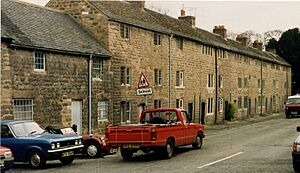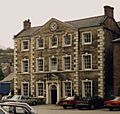Cromford facts for kids
Quick facts for kids Cromford |
|
|---|---|
 Cromford Mill |
|
 Flag |
|
| Population | 1,433 (2011) |
| OS grid reference | SK294570 |
| District |
|
| Shire county | |
| Region | |
| Country | England |
| Sovereign state | United Kingdom |
| Post town | MATLOCK |
| Postcode district | DE4 |
| Dialling code | 01629 |
| Police | Derbyshire |
| Fire | Derbyshire |
| Ambulance | East Midlands |
| EU Parliament | East Midlands |
| UK Parliament |
|
Cromford is a village in Derbyshire, England. It's in the beautiful valley of the River Derwent, located between the towns of Wirksworth and Matlock. It's about 17 miles (27 km) north of Derby. Matlock is 2 miles (3 km) to the north, and Matlock Bath is just 1 mile (1.6 km) north.
Cromford is very old! It was first mentioned in a famous book from the 11th century called the Domesday Book. Back then, it was known as Crumforde and was a small farm that supported the nearby town of Wirksworth. In 2011, about 1,433 people lived here.
Cromford is famous because of Richard Arkwright and his amazing Cromford Mill. He built this mill in 1771, and it's a big part of the Derwent Valley Mills World Heritage Site. This site is recognized by UNESCO for its special importance to world history. Historic England has even called Cromford Mill "one of the country’s 100 irreplaceable sites."
In 2018, a project to improve Cromford Mills was a finalist for an award. It was recognized for being one of the best projects to bring a historic building or place back to life.
Contents
Exploring Cromford's Landscape
The River Derwent starts far away in the hills of Bleaklow and flows south towards Derby. The land around Cromford is made of limestone, and the fast-flowing river has carved a deep valley.
This valley is an important route. The A6 road, which used to be a main road between London and Manchester, runs through it. The Cromford Canal and the Derwent Valley Line railway, connecting Derby and Matlock, were also built here.
The Via Gellia valley also joins the Derwent at Cromford. The stream in this valley is called the Ivonbrook. The name "Via Gellia" actually comes from the Gell family, who owned many mines in the area.
Cromford's Role in History
Cromford is a super important place in the story of the Industrial Revolution. This is where Richard Arkwright built his cotton mill. He used a new invention called the water frame to spin cotton using the power of water.
Many people call Cromford the "birthplace" of the Industrial Revolution. Richard Arkwright, sometimes called "The Father of the Factory System," chose this spot to build the world's first water-powered cotton mill in 1771. He was a very successful businessman.
The Gell family, who owned land nearby, built the Via Gellia road in the late 1700s. This road connected Cromford to other mining areas.
Before Arkwright, there were already some cottages and farms in Cromford. But he built a large part of the village to house his mill workers. These homes are now thought to be the first factory housing development ever built! Arkwright also provided shops, pubs, churches, and a school for his employees.
Willersley Castle, a large historic house, was also built by Richard Arkwright in 1791. After a fire, it was rebuilt and his son, Richard Arkwright junior, moved in during 1796.
In the early 1800s, a rocky area called Scarthin Nick was blasted with dynamite. This made way for what became the A6 road. This road separated Arkwright's mill complex from the village and market place.
In the 20th century, more homes were built in Cromford. A large quarry, called Dene quarry, started operating in 1942. It produces materials for roads.
In 2001, a 15-mile (24 km) area along the River Derwent was named the Derwent Valley Mills World Heritage Site. This area includes mills in Cromford, Milford, Belper, and Darley Abbey. Masson Mill, one of Arkwright's most famous buildings, is still used today as a museum and shop.
How Cromford is Managed
Cromford has a local government called the Cromford Parish Council. It helps manage the village. Historically, Cromford was part of a larger area called the Wirksworth Wapentake. This area is now known as the Derbyshire Dales District Council.
Getting Around Cromford
The A6, a main road connecting Carlisle and Luton, passes just north of Cromford. This road makes it easy to reach cities like Manchester, Stockport, Bakewell, Matlock, and Derby.
Cromford railway station has trains that run along the Derwent Valley line. These trains travel between Derby and Matlock. Services usually run once an hour in both directions.
Famous Places to See
Cromford has many important landmarks that tell its story:
- Cromford Mill (built in 1771): These buildings and the homes for workers are part of the Derwent Valley Mills World Heritage Site.
- North Street: This street was built by Arkwright for his workers. It's one of the earliest examples of housing built specifically for factory employees. Many of these homes were saved from falling apart in the 1970s.
- Masson Mill (built in 1783): This mill is located just north of the village.
- Willersley Castle: This grand castle sits on a hill with great views of Masson Mill and the village. Richard Arkwright started building it in 1790. After a fire, his son, Richard, moved in during 1796. The Arkwright family left in 1922. Later, it became a hotel and even a maternity hospital during World War II.
- St Mary's Church: Richard Arkwright also built this church between 1792 and 1797.
- Cromford Canal: This canal was built to help transport goods for the mills. It's no longer used for boats but is a special nature area. You can walk along its path from Cromford Wharf to High Peak Junction and beyond.
- Cromford and High Peak Railway: This railway, finished in 1831, connected High Peak Junction to another canal. Its old track is now a walking and cycling path called the High Peak Trail.
Well-Known People from Cromford
- Francis Hurt (1803–1861): A politician who represented a part of South Derbyshire.
- George Turner (1841–1910): A landscape artist who was born here.
- Alison Uttley (1884–1976): A famous writer who was born nearby at Castle Top Farm.
Gallery
-
The Greyhound Hotel built for Richard Arkwright in 1778 for the use of businessmen and others visiting the mills.
-
Cromford Pond built in 1785 as the pound for Cromford Mill.








